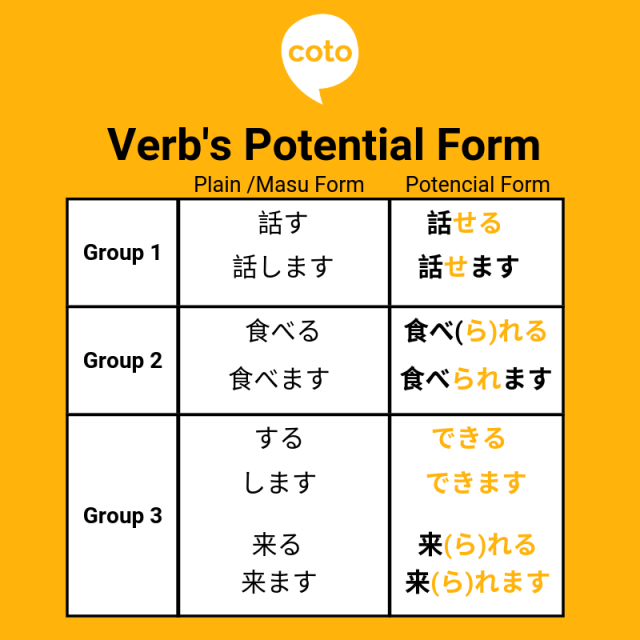Imagine you’re at a dinner party in Japan, and someone asks if you can use chopsticks. You want to say, “Yes, I can!” — but how do you say that in Japanese? Or maybe your coworker invites you to sing karaoke, but singing really isn’t your thing — how do you politely say you can’t sing?
Being able to express what you can or cannot do in Japanese is incredibly useful in daily life, whether you’re traveling, working, or making new friends. In this guide, we’ll show you how to say “I can” (できる) and “I can’t” (できない), introduce common grammar patterns, and share real-life examples to help you speak with confidence in any situation.
How to Express Ability to do Something in Japanese


1. Using the Sentence Pattern: V+ことができます
This structure is one of the most straightforward ways to express ability. It consists of three parts:
V + こと
The first part, V+こと, involves nominalizing the verb. If the verb is intransitive, like 泳(およ)ぐ (oyogu, swim), you simply add “こと” to the plain form of the verb to turn it into a noun.
Example: 泳ぐこと (to swim)
When expressing something that you can or cannot do in Japanese, you may use the following pattern:
V+ことができます
(Verb + koto ga dekimasu)
“can do (something)….
V+こと
For transitive verbs (verbs that take an object), you need to place the object with the particle を before the verb and then add “こと” at the end.
Example: 絵(え)を描(か)く e o kaku, to draw a picture.
→ 絵を描くこと (the act of drawing a picture)
が (Particle)
The particle が here acts as a subtopic marker for the nominalized verb (V+こと). It’s used to indicate the ability to perform the specific action mentioned.
The particle “が ” acts as a subtopic marker in the sentence. In this case, the subtopic is the nominalized action V+こと. Click here to learn more about this particle
できます (Verb)
The verb できます means “can” in Japanese. Its plain form is できる. If you want to express inability, change できます to its negative form: できません (cannot).
Complete example sentence
私(わたし)はフランス語(ご)を話(はな)すことができます。
Watashi wa furansugoohanasukoto ga dekimasu
I can speak French.
鈴木(すずき)さんは走(hashiru)ることができません。
Suzukisan wa hashirukoto ga dekimasen
Suzuki cannot run.
Read More: Basic Japanese Sentence Pattern
Asking & Answering a Question With できる
When asking others whether he/she can do something, simply add “か” at the back of the sentence
When you are asked a can/cannot question, simple ways to answer are: はい、できます (Yes, I can) or いいえ、できません(No, I cannot)
Example sentences:
キムさんは弁当(べんとう)を作(つく)ることができますか。
Kimusan wa bentou o tsukurukoto ga dekimasuka
Kim, can you make bentos?
はい、できます。
Hai, dekimasu
Yes, I can.
ペンギンは飛(と)ぶことができますか。
Pengin wa tobukuto ga dekimasuk
Can penguins fly?
いいえ、できません。
Iie, Dekimasen
No, they can’t.
Using Potential Japanese Verbs
Another way to express can or cannot do something is by using potential verbs.
Potential Verb Transformation Rule
Group 1: Change the final vowel to the one on the “え column” of the same role then add “る” to the back.
Group 2: Remove “る” at the back and add “られる” (“ら” is sometimes omitted in oral Japanese)
Group 3: する ―できる 来るー来(こ)られる

Example Sentences
コンビニでATM が使(つか)えます.
Conbini dewa ATM ga tsukaemasu
ATM can be used at a convenience store.
レストランでおいしい料理(りょうり)が食(た)べられます.
Resutoran de oishiiryouri ga taberaremasu
You can have delicious food at a restaurant.
私(わたし)は家(いえ)で勉強(べんきょう)できません.
Watashi wa iede benkyoudekimasen
I can’t study at home.
Now that you have learned the 2 ways of expressing ability in Japanese. What about asking the 5W1H questions in Japanese?
If you are interested in studying Japanese in Tokyo, find out more about our school by filling out the form below.
Want to learn more Japanese phrases? Read our guide on:
- How to Use Ganbaru, Ganbatte and Ganbare
- What Does Senpai (先輩) Mean in English?
- How to Use San, Sama, Kun
- How to Use Otsukaresama Desu in Japanese
- How to Say “Please” in Japanese
FAQ
What is an example of できます?
An example is “I can play the piano” – Piano o hiku koto ga dekimasu.
What does どう mean in Japanese?
Dou means “how” and is used to ask about the way or condition of something.
What does そんなに mean in Japanese?
Sonna ni means “so much” or “that much,” often used to emphasize a degree or extent.
What does なんかい (何回) mean in Japanese?
Nankai means “how many times.”
How do you say “I can” in Japanese?
You can say “I can” using koto ga dekimasu or by using the potential form of a verb like taberaremasu (“can eat”).
